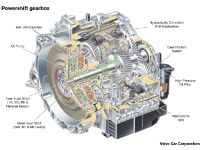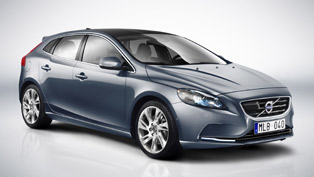Smooth Powershift gearbox cuts fuel consumption by 8 percent in the Volvo C30, S40 and V50
The two-litre turbodiesel version of the Volvo C30, S40 and V50 is now also available with a fully-automatic transmission.
This new Powershift transmission is a six-speed unit and it significantly cuts fuel consumption compared with a conventional automatic transmission.
"According to our calculations, Powershift contributes to a fuel consumption saving of about eight percent compared with a conventional automatic transmission," says Magnus Jonsson, Senior Vice President, Research & Development, Volvo Cars.
The Powershift transmission has been developed by Volvo Cars in cooperation with its transmission partner Getrag. Powershift operates in principle as two parallel manual gearboxes. It has twin wet clutches that work independently of one another. One clutch controls the odd gears (1, 3, 5 and reverse) while the other handles the even gears (2, 4 and 6). The two clutches operate alternately, with one engaging while the other disengages.
This means that at the same time as the engine gets full power and maximum thrust in first gear, second gear is placed in readiness to be engaged. And when second gear has been engaged, third gear is readied, and so on. This promotes a continuous flood of power without any disruption in power delivery or any torque loss, resulting in extremely fast and silky-smooth gearchanges while maintaining acceleration throughout the gearchanging process.
Electro-hydraulic control promotes smooth operation
The Powershift function is based on the technology used in a manual gearbox but with the difference that the two wet clutches are each linked with their own input shaft. One shaft spins inside the other. The inner shaft regulates the output shaft for first, third, fifth and reverse gears, while the outer shaft controls second, fourth and sixth gears. The clutch function is operated by an electro-hydraulic control unit that ensures that one clutch is shut while the other is open, and vice versa.
Each clutch functions like a slip clutch. A piston pushes a number of clutch plates against each other and locks them together through the resultant friction.
Automatic or sequential gearchanging without any loss in torque
Powershift gives the driver an automatic transmission that permits sequential gearchanges, just like with Volvo's Geartronic transmission. The difference is that with Powershift even manual gearchanges take place without any time or power losses.
Since Powershift, unlike a conventional automatic transmission, does not need a torque converter, planetary gears or multiple wet clutches, there is also none of the added torque losses that these features bring.
Optimal choice for powerful diesel engines
Thanks to the use of twin wet clutches, the Powershift transmission can handle high torque levels and in principle has no limitations on choice of ratio. This makes it an ideal partner for today's modern, powerful diesel engines.
The version of Powershift that Volvo is now launching is dimensioned to handle torque levels of up to 450 Nm.
In addition to the Volvo C30, Powershift is also available in the Volvo S40 and V50. In all three models the Powershift transmission is mated to the 2-litre four-cylinder turbodiesel, which delivers a power output of 136 hp and 320 Nm of torque. Fuel consumption (EU combined) is 5.9 l/100 km for the C30 and 6.0l/100 km for the S40 and V50.
"With Powershift we can now offer automatic transmission with our two-litre diesel engine," says Magnus Jonsson. "And it's not just any old automatic transmission: lower fuel consumption combined with increased comfort and higher performance sounds like an impossible equation. But with Powershift we have shown that this is perfectly possible."










